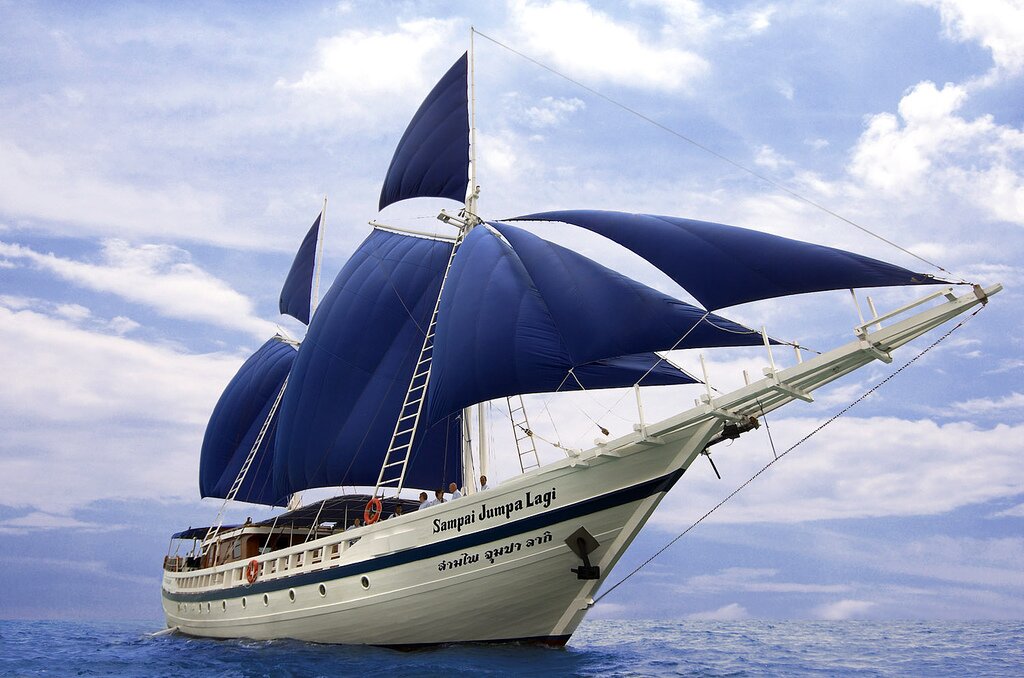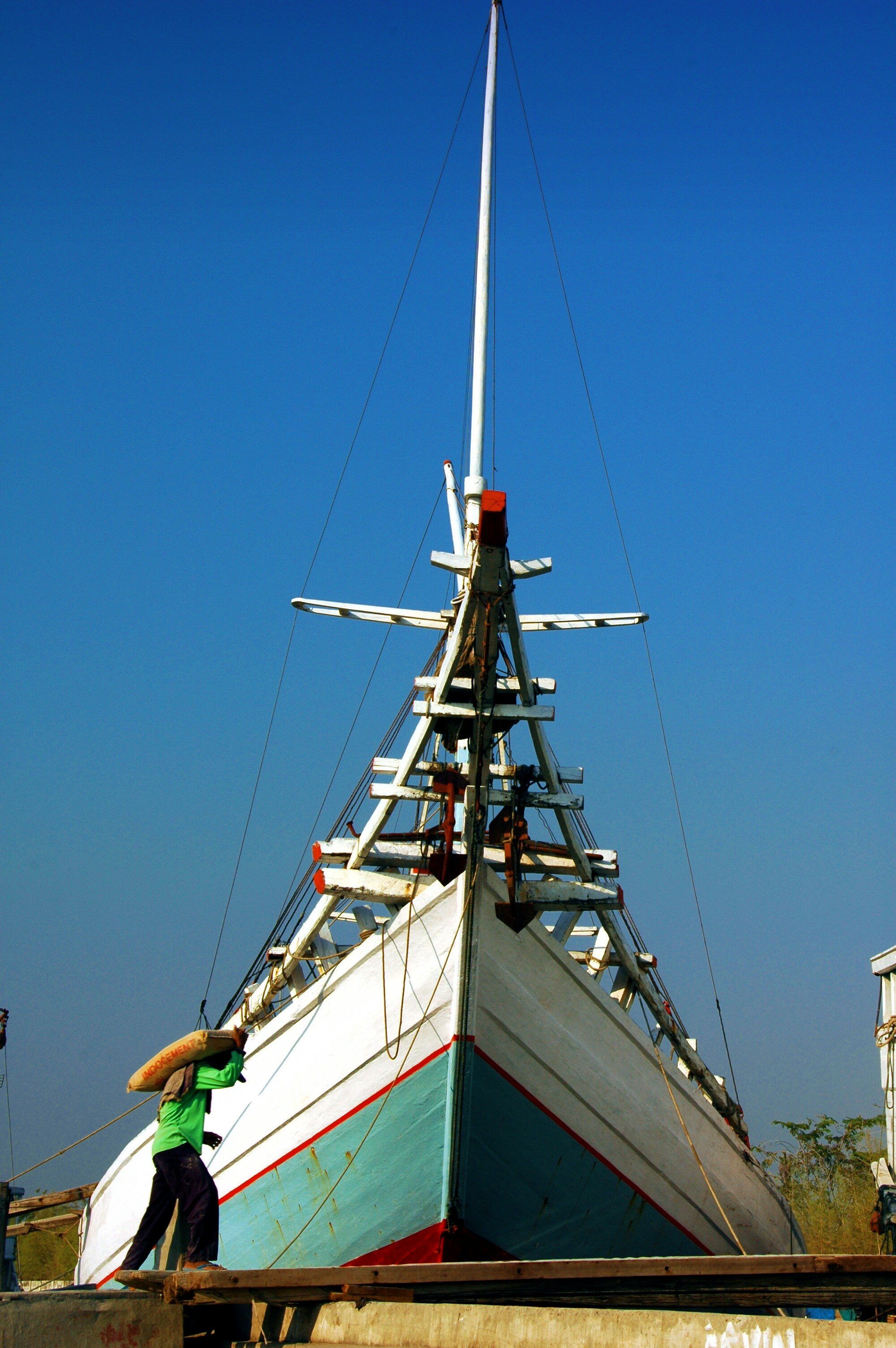Want to sail one?
Hitching a Ride – A traveller we talked to had his girlfriend with him when he tried to hitch a ride with a genuine pinisi from Sunda Kelapa harbour, Jakarta. The captains of the pinisi consistently declined to take them on as passengers. ,,After days somebody told us they refused us because they thought me and my girlfriend would be too intimate on board.´´
The boat people, from the Bugis tribe, are very superstitious and they feel that too much intimacy on board brings bad luck. ,,After I introduced her as my sister we quickly found a boat that brought us from Java to Jambi, in southeast Sumatra. But that was in the seventies.´´
Telling white lies these days will not get you onboard a real pinisi anymore, simply because there is hardly any left. Although hitching a ride in Indonesia with a wooden sailing boat is still easy, it is very difficult to find an original pinisi. The beginning of the seventies are regarded as the most succesful years for the pinisi as a sailing vessel. But that epoch is over. In 1978 the Indonesian government started a campaign to phase out the sail alone pinisi. It has changed the appearance of Indonesian ports considerably.
The old pinisi (´palari pinisi´) had not only two masts and seven or sometimes eight sails, but also an elegant bow and stern, not unlike the decks of western clippers. The introduction of the engine has changed this. They actually found out that it technically was not easy to install an engine and shaft into a sharp-ended traditional hull, and hence went for the square-sterned ‘western’ model.
To compensate for the torque forces an engine exerts on a construction only designed to withstand the forces of wind and water on backwind courses, the aft part of the pinisi became bigger, heavier, wider and higher. Because of the high aft deck, built to accommodate the pilothouse, some regard these modern pinisis as just plain ugly. Furthermore, the aft mast, the mizzen mast, has gone.
The result is a ship with a fore part that has a classic look, and an aft part from modern times. In Indonesia these new ships are referred to as KLM, for Kapal Layar Mesin, literally translated as ´Motor Driven Sailing Vessel´.
These KLM´s are the boats you will find in most of the Indonesian harbours. However, things are even changing for these KLM´s, as anthropologist and regional maritime historian Horst Liebner discovered in 2009: ,,During this year I passed a lot of times along Sunda Kelapa harbour, Jakarta, and had the impression that they now even take down the top masts on the remaining single mast.
They turn the mast into a crane, not ready to take on sails any more. They however have to show off with some canvas as they thus are classified as KLM (kapal layar motor, motorised sailing ship) which don’t have to comply to the full set of rules for cargo vessels; this they seemingly do by having a jib somewhere.´

Pinisi charter yacht, Indonesia, 2004 © Worldwide Dive and Sail
We will mention here the ports in Indonesia with the largest concentration of pinisi, mainly KLM´s. If you are very lucky you can find a traditional pinisi around here. However, your chances of finding one are not very high. The search for the most traditional pinisi from Indonesia could be the quest of lifetime. Indigenous Sails asked several experts in Indonesia for the remaining number of real pinisi.
One of our sources estimated that only around 30 of them are left. Others say that even that is too optimistic. Their places are obviously not known, since they ply Indonesian waters all the time.
A further number of 96 traditional vessels was in a recent report to the Indonesian Minister of Tourism mentioned as the number of traditional pinisi used by charter companies in the tourism industry. Most of them are in use by the companies we will mention under the chapter ,rent a boat´. They usually have shorter masts than the original ones and are not made for sail-driven voyages, but for scheduled runs with tourists where the engine is on all the time.
To find one of these approximately thirty original ships, with two masts and seven sails, you have to think like a trader supplying the most remote harbours of Indonesia, the ones ignored by most boatsman because profits are marginal. Such a search will bring you to the most remote corners of the Indonesian archipelago, like small ports of Borneo or Irian Yaja or the lesser Sunda Islands.
Here is a hint to find them. The traditional boats, the ones that prefer to sail with back winds, adapt since centuries to the monsoon patterns. Between October and March the northwest monsoon winds (called the ,west monsoon´) are blowing. And between April and September its the other way around, then southeast winds (called the ´east monsoon´) are prevalent. So you have most chance of finding a seven sail pinisi in the southeastern part of Indonesia between October and March, and in the northeastern part in April and September.
Look in the chapter ,Where can you find pinisi´to see the places where in Indonesia with the largest concentration of (modern) pinisi.

Sunda Kelapa Harbour, Jakarta, Indonesia, 2009 © Loose Grip
A beautiful but very time consuming trip as a ´hitcher´ would be to go from Jakarta to Surabaya, then to Makassar, Kalimantan and then back to Jakarta again. However, you need to be very luck to find a captain that can take you from Kalimantan back to Java. You have most chance to hitch a ride on the traditional and downtrodden maritime waterways. Most traditional routes are between java and Sumatra or are circle runs between Sulawesi and Kalimantan.
,,It is quite easy to hitch a ride between Surabaya and Makassar´´, says antropologist and traveller Horst Liebner. ,,Going to Kalimantan is a little hazardous as it would be hard to find transport on from the small river-ports they go collecting timber in. They are very much aware that a good part of the timber trade is illegal, and they don’t really want you to see it.´´
Indonesian sailors are usually from the Bugis, a tribe known to be fierce merchants and rogues. They are also known for their hot tempered attitude. Originally they are from the southern part of Sulawesi, but now they have colonies in almost every Indonesian port. On the ships in Western Indonesia it would be mainly Sulawesian immigrants’ offspring who man the vessels, often speaking Makassar, Mandar or Bugis, but more often Malay and the local language of their new homes.
These Bugus people are the ones you will most likely deal with when you try to hitch a ride to some far flung Indonesian place. Learn a few Bugis words by heart to break the ice. However, most important, you should have an Indonesian with you who you trust and who is fluent in Bahasa Indonesia. Of course, you can learn some Bahasa yourself.
Be prepared for a long trip and be flexible. These ships might change their itinerary easily, and you can be stuck in remote places awhile. You might try to convince the owner to take you on as crew. But most likely he will not accept you since you are a novice and are more likely to be hampering the work then helping him. In other words: you have to pay for your passage.

Pinisi under full sail, Indonesia, 1946 © George White
Renting a Boat – According to Indonesian law it is impossible to rent out a pinisi without a local skipper, ´Bareboat charter´ does not exist in Indonesia, like it does for, for example, for the jangada in Brazil. There are dozens of charter companies in Indonesia that offer cruising trips with traditional boats.
There is, however, plenty of opportunity to charter a boat with a crew. Here is a list of charter companies that uses pinisi, in less or more traditional form. The popularity of the pinisi in the tourism industry is the only reason why new seven sails pinisi are being built these days. The only difference with the original ones are usually that the two masts are shorter, which makes them less efficient sailing boats.
Choose your company careful. Tell them you want to learn as much as possible about the pinisi as a sailing vessel, and you also want to stand behind the helm and do some basic maneuvering yourself. Some companies are more willing to teach you what they know then others. For several of these firms their seven sail pinisi is just an efficient way to attract customers who are interested in surfing or a luxury holiday, while others have a true passion for sailing. Here the main charter companies that use pinisi:
- Sea Trek Sailing Adventures,
- Songline Cruises,
- Blue Water Cruises,
- Sea Safari Cruises.
Building a Pinisi – Many foreigners in the last two decades became fascinated by the pinisi and have decided to go to Indonesia and have one built for themselves. The popularity of using the replicas of traditional pinisi as charter boats started halfway during the nineties and is not over yet. More than one hundred boats have been build for foreign clients by Indonesian ship yards, mainly on the islands of Sulawesi and Kalimantan.
Many of these boats are now working as charter boats. Other companies ordered a pinisi in Indonesia and had them sailed back to the Western world, to be used for example as a ,pirate ship´ on Western boat shows.
The biggest hassle with having a pinisi built for you is the horrendous bureaucracy in Indonesia and the endless delays. In the past Western individuals tried to do the supervison of the building themselves, but now there is a trend to involve local Western agents with contacts at shipyards.
The biggest advantage might be that you yourself do not need to be there personally all the time anymore to check progress. Some of the companies mentioned above offer these services.
As far as we know there are currently only two modern naval architects designing pinisi; Kasten Marine in the United States and Kakanoo Marine in Indonesia.
,We could not find a classification society´ - certification
This country (your ,flag country´) can have a range of requirements. They are more strict when you want your boat to operate commercially. One of them is that the building of your boat needs to be overseen by a well known classification society, like Lloyds or Det Norske Veritas.
This means that one of the employees of such a ´society´ regularly needs to visit the yard to check of your ship is build according to international safety standards, the so-called SOLAS-criteria. Without their approval no certificate of seaworthiness will be issued and no registration in your country can follow.
Make sure the certification society your country recognizes has an office in the country where you want to have your indigenous ship build.
Robin Engel, owner of Songline Yachts in Indonesia, works with local yards for Westerners who order a pinisi with Songline. One of Engels clients came across this certification problem. ,,A Frenchmen gave us a design plan for a fifty metres pinisi that he wanted us to build for him.
We spent seven months trying to find a certification company, like Lloyds, that could give a official classification to the boat. We could not find any.´´
,,Their local representatives were not willing to come over here and check the progress and quality of the building process. In the end the boat could not be certified and therefore not be built. You have to know where you are going to flag your ship and build it to the standards of that country.
Before you give a ship designer a assignment make sure you know what the requirements are of your potential flag country.´´




